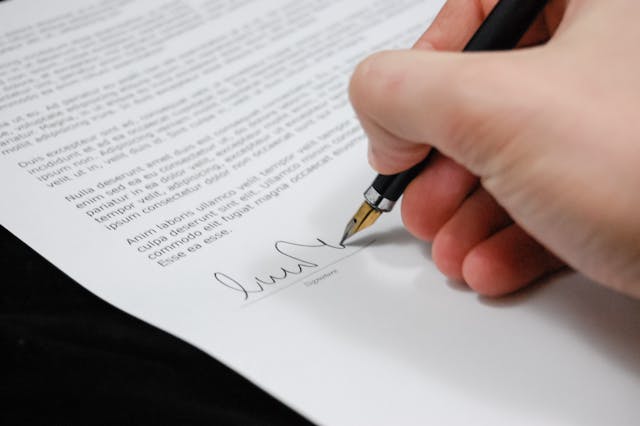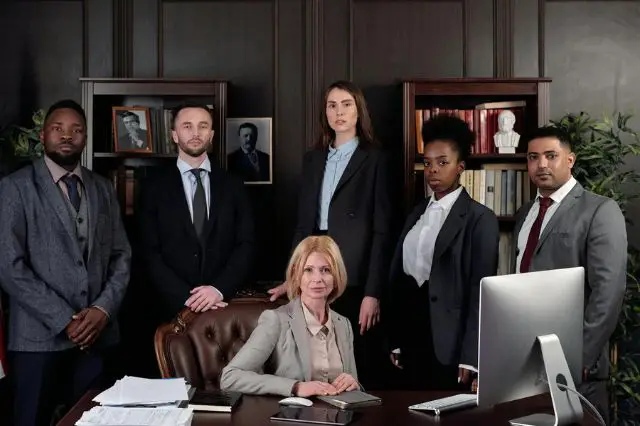Law
Finding Common Ground: A Comprehensive Guide to Divorce Mediation


Divorce is a challenging life event that can be emotionally and financially draining for everyone involved. In such times of distress, divorce mediation emerges as a constructive alternative to traditional litigation. This process focuses on communication, cooperation, and compromise, helping couples navigate the complexities of divorce with less conflict and stress.
In this article, we will delve into the world of divorce mediation, exploring its benefits, process, and how it compares to litigation.
Understanding Divorce Mediation
What is Divorce Mediation?
Divorce mediation is a voluntary process in which a neutral third party, known as a mediator, assists divorcing couples in reaching agreements on various aspects of their divorce, such as property division, child custody, spousal support, and more. Unlike litigation, which involves a judge making decisions, mediation empowers the couple to actively participate in shaping the terms of their divorce.
Benefits of Divorce Mediation
1. Reduced Conflict: Mediation promotes open dialogue and collaboration, reducing hostility and animosity between the parties involved. This approach is particularly beneficial when there are children, as it helps maintain a more amicable post-divorce relationship.
2. Cost-Effective: Mediation is often more affordable than traditional litigation. By avoiding prolonged court battles, couples can save substantial legal fees.
3. Faster Resolution: Mediation tends to be quicker than litigation, which can drag on for months or even years. With timely resolution, individuals can move forward with their lives sooner.
4. Control over the Process: Mediation allows couples to retain control over the decisions that impact their lives. This level of involvement can lead to more satisfying and personalized outcomes.
5. Confidentiality: Unlike court proceedings, mediation is private and confidential. This can encourage open communication without the fear of sensitive information becoming public.
The Divorce Mediation Process
Initiating Mediation
The mediation process typically begins with both parties agreeing to mediate and selecting a qualified mediator. This mediator should be neutral, impartial, and experienced in family law matters.
Introductory Sessions
During the initial sessions, the mediator explains the mediation process, its benefits, and the ground rules. Each party has the opportunity to express their goals and concerns. This sets the tone for respectful and constructive communication.
Information Gathering
Both parties provide financial documents, including assets, liabilities, and income. This transparency ensures that decisions are made based on accurate and complete information.
Negotiation and Decision-Making
The heart of mediation involves identifying key issues and working together to find mutually acceptable solutions. The mediator facilitates discussions, helping the couple brainstorm and evaluate different options.
Agreement Drafting
Once agreements are reached, the mediator drafts a formal document outlining the terms. It’s essential for both parties to review this document carefully to ensure accuracy and understanding.
Legal Review
While mediators are well-versed in family law, they don’t provide legal advice. It’s advisable for both parties to have the agreement reviewed by their respective attorneys before finalizing.
Finalizing the Divorce
Upon agreement, the couple submits the documents to the court for approval. The court’s role is generally limited to ensuring the agreement meets legal standards and doesn’t violate any laws.
Comparing Mediation to Litigation
Control and Decision-Making
In mediation, couples have an active role in decision-making, while litigation relies on a judge’s ruling. Mediation fosters a sense of empowerment and ownership over the outcome.
Time and Efficiency
Mediation tends to be quicker than litigation. Court processes can be time-consuming, often leading to frustration and extended emotional stress.
Cost Considerations
Mediation is generally more cost-effective due to shorter timelines and reduced legal fees. Litigation can quickly accumulate expenses through court fees and attorney billing.
Emotional Impact
Mediation promotes healthier communication and cooperation, reducing emotional turmoil, especially crucial when children are involved. Litigation can exacerbate tensions and negatively affect family dynamics.
Privacy and Confidentiality
Mediation ensures privacy, while litigation involves public court records. Confidentiality can encourage more open discussions and creative problem-solving.
Navigating the Emotional Challenges
Acknowledging Emotions
Divorce is an emotional journey, and divorce mediation recognizes this aspect. During the process, mediators provide a safe space for both parties to express their feelings, concerns, and anxieties. This emotional outlet can help ease the tension and allow for a more productive negotiation.
Focusing on Communication
Effective communication is at the core of divorce mediation. Mediators work to improve communication between the divorcing couple, helping them express their needs and concerns more constructively. This skill is not only valuable during the mediation process but also in co-parenting and post-divorce interactions.
Child-Centric Approach
For couples with children, divorce mediation offers a child-centric approach that prioritizes the well-being of the children. Through open discussions and compromise, parents can create a parenting plan that addresses custody, visitation, and other child-related matters in the best interests of their children.
Managing Power Imbalances
Mediators are trained to address power imbalances that may exist between the parties. They ensure that both individuals have an equal voice and that decisions are made collaboratively. This balanced approach contributes to more fair and just agreements.
The Role of the Mediator
Neutrality and Impartiality
A skilled mediator remains neutral and impartial throughout the process. They don’t take sides or make decisions for the couple. Instead, they guide the conversation, ensure both parties are heard, and facilitate a productive dialogue.
Conflict Resolution Skills
Mediators are equipped with conflict resolution skills that help parties navigate disagreements and disputes. Through techniques such as active listening and reframing, they encourage healthy conversations and help find common ground.
Customized Solutions
Mediators understand that every couple’s situation is unique. They work to tailor solutions that meet the specific needs and preferences of each party, fostering a greater sense of satisfaction with the final agreements.
Legal Knowledge and Documentation
While mediators don’t provide legal advice, they possess a sound understanding of family law. This ensures that any agreements reached are in line with legal requirements and can be smoothly processed by the court.
Post-Mediation Considerations
Long-Term Viability
Agreements reached through mediation are often more enduring because they are crafted by the parties involved, rather than imposed by a court. This reduces the likelihood of future disputes and modifications.
Cooperative Co-Parenting
Mediation encourages a cooperative co-parenting relationship, which is especially vital for the children’s well-being. By fostering collaboration, parents can effectively address changing circumstances and make necessary adjustments to their parenting plan.
Flexibility and Adaptability
Life is unpredictable, and circumstances can change over time. Mediation agreements can be more flexible and adaptable, allowing parties to modify terms as needed, provided both parties agree.
Continued Communication
Divorce mediation promotes ongoing communication between ex-spouses. This communication can be instrumental in addressing unexpected challenges, maintaining a respectful relationship, and ensuring the well-being of any shared children.
Conclusion: A New Beginning
Divorce mediation stands as a beacon of hope amid the storm of divorce. By emphasizing collaboration, communication, and understanding, it offers a way to navigate the complexities of separation with grace and dignity. From emotional healing to practical solutions, mediation provides a comprehensive approach that supports families in transitioning to a new chapter of their lives. As you consider your options for divorce, remember that mediation isn’t just about reaching an agreement – it’s about building a foundation for a more harmonious post-divorce future.
Law
Estate Planning Essentials: Wills, Trusts, and Protecting Your Assets


Estate planning is a critical aspect of financial management that often goes overlooked until it becomes a pressing necessity. Proper estate planning ensures that your assets are distributed according to your wishes, reduces the burden on your loved ones, and helps avoid costly legal battles.
This comprehensive guide will explore the essentials of estate planning, focusing on the importance of wills, trusts, and the various strategies for protecting your assets. With professional guidance from The Maddox Firm, you can navigate the complexities of estate planning and secure your legacy for future generations.
Understanding Wills
A will is a foundational document in any estate plan. It outlines your wishes regarding the distribution of your assets after your death and appoints guardians for any minor children. Without a will, your estate will be subject to intestacy laws, which means the state decides how your assets are distributed. This process can be time-consuming, expensive, and may not align with your wishes.
Creating a will involves several key steps. First, you must inventory your assets, including real estate, bank accounts, investments, and personal belongings. Next, you need to decide who will inherit these assets. This could be family members, friends, or charitable organizations. It’s also essential to appoint an executor, who will be responsible for managing your estate and ensuring your wishes are carried out.
One critical decision in your will is naming a guardian for your minor children. This decision should not be taken lightly, as the guardian will be responsible for their upbringing and welfare. Discussing this role with the chosen individual is crucial to ensure they are willing and able to take on this responsibility.
The Role of Trusts
While wills are essential, they are only sometimes sufficient to cover all aspects of estate planning. This is where trusts come into play. A trust is a legal arrangement where a trustee holds and manages assets on behalf of beneficiaries. Trusts can provide several benefits, including privacy, probate avoidance, and potentially significant tax advantages.
There are different types of trusts, each serving specific purposes. A living trust, also known as a revocable trust, allows you to manage your assets during your lifetime and specifies how they should be distributed upon your death. One of the primary benefits of a living trust is that it helps avoid probate, a legal process that can be lengthy and costly.
Another common type is an irrevocable trust, which cannot be altered once established. Irrevocable trusts are often used for tax planning and asset protection. By transferring assets into an irrevocable trust, you remove them from your taxable estate, potentially reducing estate taxes. Additionally, assets in an irrevocable trust are typically protected from creditors.
Special needs trusts are designed to provide for a loved one with disabilities without jeopardizing their eligibility for government benefits. These trusts ensure that funds are available to enhance the beneficiary’s quality of life without disqualifying them from essential services.
Protecting Your Assets
Protecting your assets is a crucial component of estate planning. Your assets can be vulnerable to creditors, lawsuits, and other financial risks without proper protection. One effective strategy is asset titling, which involves structuring ownership of your assets to minimize risk. For example, holding assets jointly with a spouse can provide some protection from creditors.
Another strategy is using insurance to safeguard your wealth. Life insurance can provide liquidity to cover estate taxes and other expenses, ensuring your assets are preserved for your heirs. Long-term care insurance can also protect your estate from the high costs of nursing home care. Disability insurance is another critical consideration, ensuring a steady income stream even if you cannot work due to illness or injury.
In addition to insurance, creating a family limited partnership (FLP) can offer significant asset protection benefits. An FLP allows you to transfer ownership of assets to family members while retaining control over their management. This structure can shield assets from creditors while facilitating the transfer of wealth to the next generation.
Another effective strategy is establishing an asset protection trust. These trusts are designed to protect your assets from potential creditors and lawsuits. Placing assets in an asset protection trust can create a legal barrier between your wealth and potential claimants. These trusts are often irrevocable, meaning they cannot be altered once established, providing high security for your assets.
Utilizing retirement accounts is another way to protect your assets. Certain retirement accounts, such as 401(k)s and IRAs, offer creditor protection under federal law. By maximizing contributions to these accounts, you can grow your wealth while safeguarding it from potential creditors.
Additionally, implementing prenuptial and postnuptial agreements can be prudent in protecting your assets. These agreements outline how assets will be divided in the event of a divorce, ensuring that your estate plan remains intact and your assets are distributed according to your wishes.
Conclusion
Estate planning is not a one-time event but an ongoing process that requires careful consideration and regular updates. Wills and trusts are essential tools that help ensure your wishes are honored and your assets are protected.
By understanding the differences between wills and trusts and implementing strategies to safeguard your wealth, you can create a comprehensive estate plan that provides peace of mind for you and your loved ones. Seeking professional guidance from The Maddox Firm can simplify this complex process and help you achieve your estate planning goals, securing your legacy for future generations.
Law
Legal Lifelines: How Personal Injury Attorneys Rescue Your Rights and Recovery


Life can take a sharp turn in the blink of an eye. One moment, you’re going about your day as usual; the next, you find yourself grappling with the aftermath of an injury.
The consequences can be profound, whether it’s a car crash, a workplace mishap, or a slip-and-fall incident. They can affect your physical health, financial stability, and emotional well-being.
In such moments of crisis, personal injury attorneys emerge as the unsung heroes, extending a lifeline to those in need. With their expertise, dedication, and unwavering commitment to justice, these professionals play a pivotal role in safeguarding individuals’ rights and recovery.
The Anatomy of a Personal Injury Case
It’s important to comprehend the components of a personal injury case before diving into the priceless contributions made by personal injury attorneys. Fundamentally, a personal injury claim occurs when someone is harmed as a result of the careless, reckless, or malicious actions of another party.
This harm can encompass a broad spectrum of injuries, ranging from physical to psychological. Moreover, it can occur in various settings, including on the road, at work, or on someone else’s property.
There are various types of personal injuries that you can suffer. Some of these injuries include vehicle accidents, slip-and-falls, medical malpractice, product liability, wrongful deaths, etc.
Once a personal injury occurs, the injured party can file a lawsuit to seek compensation. Consider the example of a recent car accident in Chicago, Illinois (IL). As covered by an NBC Chicago news article, two pedestrians were severely injured in a car crash. The crash occurred in the Ukrainian Village in Chicago, IL.
Both pedestrians were taken to the Stroger Hospital. Treating the injuries required a lot of medical expenses. Since the accident was not the pedestrians’ fault but that of the driver who crashed the vehicle, the victims can seek compensation. This can be done through a personal injury lawsuit.
Personal injury attorneys in Chicago, IL, can help the victims build a strong case against the negligent driver. They can help the pedestrians seek the rightful compensation for their damages.
There are several other things that personal injury lawyers can do to help a victim throughout the legal proceedings.
The Role of Personal Injury Attorneys
Personal injury attorneys are the guiding light in this intricate dance of legal proceedings. They help navigate the maze of statutes, regulations, and precedents precisely and skillfully.
Their multifaceted role encompasses a myriad of responsibilities, each geared towards protecting the rights and interests of their clients.
Legal Expertise and Advocacy
Their profound understanding of tort law is central to personal injury attorneys’ mission. It is the branch of civil law that governs personal injury claims. Armed with this knowledge, they meticulously analyze each case’s circumstances, identifying potential legal theories and avenues for recourse.
Whether it’s establishing negligence, proving causation, or quantifying damages, these legal experts leverage their expertise to construct compelling arguments. Moreover, personal injury attorneys serve as staunch client advocates, tirelessly championing their cause in negotiations and courtrooms.
Negotiation and Resolution
One of the hallmark skills of personal injury attorneys is their adeptness at negotiation. According to Nolo, personal injury negotiation requires contacting the insurance claims adjuster. Moreover, you need to have a settlement amount and avoid jumping on the first offer you get.
Negotiating might sound simple, but it is not. Insurance companies use different tactics to determine a settlement amount. This is where personal injury lawyers can help. Recognizing that most cases are resolved through settlements rather than trials, these attorneys employ strategic negotiation tactics to secure favorable outcomes.
Resource Mobilization and Support
Beyond their legal acumen, personal injury attorneys are a vital source of support and guidance for their clients. Recognizing the emotional and financial strain associated with personal injury claims, these attorneys provide much-needed reassurance and assistance at every step.
From coordinating medical treatment to facilitating communication with medical providers, personal injury attorneys streamline the recovery process. They alleviate the burden on their clients and allow them to focus on healing.
They frequently operate on a contingency fee basis as well, which means they only get paid if and when their clients get paid. This arrangement guarantees everyone, regardless of income level, access to legal representation.
How to Find the Right Personal Injury Lawyer for Your Case
According to IBISWorld, there were 50,693 personal injury lawyer businesses in the USA in 2023. This shows that there are ample options available when it comes to choosing a lawyer for your case.
Finding the right personal injury lawyer for your case is crucial to ensure you receive the best representation and outcome. Here are the steps you can take to find the right attorney:
- Identify your needs: Understand the specifics of your case. Personal injury law covers many situations, including car accidents, medical malpractice, workplace injuries, slip and fall accidents, etc. Determine the type of injury you’ve sustained and the circumstances surrounding it.
- Research: Use various resources to find potential lawyers. You can start with:
- Personal recommendations from friends, family, or acquaintances who have used personal injury lawyers.
- Online directories of attorneys.
- Bar association websites often have directories of lawyers categorized by specialty.
- Online review platforms to see what previous clients have said about different lawyers.
- Check credentials and experience: Look for lawyers who specialize in personal injury law and have experience handling cases similar to yours. Check their credentials, education, certifications, and any awards or recognition they may have received. Experience in the local court system can also be beneficial.
- Evaluate communication and rapport: Pay attention to how well you communicate with the lawyer during the consultation. A good lawyer should listen to your concerns, answer your questions clearly, and make you feel comfortable. Building a rapport with your lawyer is important as you will work closely throughout your case.
- Consider reputation and track record: Look into the lawyer’s reputation within the legal community and their track record of success in handling personal injury cases. You can search for any disciplinary actions or complaints against the lawyer through the state Bar Association.
- Trust your instincts: When choosing a personal injury lawyer, trust your instincts. Select someone you feel will effectively represent your interests and who you believe will work diligently to achieve the best possible outcome for your case.
Frequently Asked Questions
What Are the Benefits of a Personal Injury Lawyer?
Hiring a personal injury lawyer offers numerous benefits, including legal expertise, resource access, peace of mind, etc.
How Do I Prepare to Meet a Personal Injury Lawyer?
The process of hiring a personal injury lawyer usually starts with an initial meeting to analyze your case. Before the meeting, you should gather relevant evidence, note down any details, and prepare questions to ask.
What Are the Most Common Types of Personal Injury Cases?
Personal injury is a broad area of law encompassing different types of cases. Some of the most common types of personal injury cases include vehicle accidents, slips and falls, medical malpractice, and product liabilities.
To conclude, personal injury attorneys serve as beacons of hope, guiding injured individuals through the labyrinth of legal proceedings. These legal lifelines play a pivotal role in safeguarding the rights and recovery of those grappling with the aftermath of accidents and injuries.
Personal injury attorneys embody the essence of justice as pillars of support and agents of change. They ensure that no injury goes unanswered and no injustice goes unchallenged. In the grand tapestry of the legal landscape, they stand as champions of the vulnerable, illuminating the path to healing, restitution, and redemption.
Law
Navigating #MeToo: How Sexual Harassment Lawyers in Las Vegas Can Support Your Claim


In recent years, the #MeToo movement has sparked a global conversation about sexual harassment and assault. People from all walks of life have come forward to share their stories, leading to increased awareness and accountability. Las Vegas, a city known for its vibrant entertainment and bustling nightlife, is no exception to these issues.
If you’ve experienced sexual harassment in Las Vegas, you don’t have to face it alone. Sexual harassment lawyers in Las Vegas can provide the support and legal expertise you need to navigate your claim and seek justice. To hire the best lawyers, click here: Sexual Harassment Lawyers Las Vegas.
Understanding Sexual Harassment
Before delving into how sexual harassment lawyers in Las Vegas can assist you, let’s first understand what sexual harassment entails. Sexual harassment is a form of gender-based discrimination that violates Title VII of the Civil Rights Act of 1964. It can occur in various settings, including the workplace, public spaces, or even online. Sexual harassment can manifest in different ways:
1. Quid Pro Quo Harassment
Quid pro quo harassment occurs when someone in a position of power requests sexual favors in exchange for employment benefits, such as a promotion or job security. It creates an intimidating and hostile environment, forcing victims to comply with unwelcome advances to maintain their livelihood.
2. Hostile Work Environment
A hostile work environment arises when offensive comments, unwelcome advances, or inappropriate behavior create an atmosphere that is hostile, intimidating, or offensive. This type of harassment can come from supervisors, coworkers, or even customers.
3. Online Harassment
With the rise of social media and online platforms, sexual harassment has extended into the digital realm. Online harassment can involve cyberbullying, explicit messages, or the sharing of explicit content without consent.
The Importance of Legal Representation
If you’ve experienced sexual harassment in Las Vegas, seeking legal representation is a crucial step towards justice. Sexual harassment lawyers in Las Vegas can provide several benefits to support your claim:
1. Expertise in Sexual Harassment Laws
Sexual harassment laws can be complex and vary from state to state. Experienced lawyers in Las Vegas are well-versed in both federal and Nevada-specific laws related to sexual harassment. They can help you understand your rights and the legal options available to you.
2. Personalized Guidance
Every sexual harassment case is unique, and lawyers in Las Vegas understand this. They will provide you with personalized guidance tailored to your specific situation. This ensures that you receive advice and strategies that align with your goals.
3. Investigation and Evidence Gathering
One of the key roles of sexual harassment lawyers is to conduct thorough investigations into your case. They will gather evidence, interview witnesses, and collect documentation to build a strong case on your behalf. This includes preserving any relevant emails, text messages, or other forms of communication.
4. Negotiation and Settlement
Many sexual harassment cases are resolved through negotiation or settlement rather than going to court. Lawyers in Las Vegas have the negotiation skills to advocate for your interests and secure a fair settlement that compensates you for your suffering and losses.
5. Representation in Court
If a settlement cannot be reached, your sexual harassment lawyer in Las Vegas will represent you in court. They will present your case, cross-examine witnesses, and argue on your behalf to seek justice through litigation.
Steps to Take When Faced with Sexual Harassment
If you believe you’ve experienced sexual harassment in Las Vegas, it’s important to take specific steps to protect your rights and strengthen your case. Here’s a step-by-step guide:
1. Document Everything
Start by documenting every instance of harassment. This includes writing down dates, times, locations, and descriptions of what happened. If there are witnesses, try to obtain their contact information.
2. Preserve Evidence
Preserve any evidence related to the harassment. This includes text messages, emails, voicemails, or any physical evidence that may exist. It’s crucial to prevent any potential destruction of evidence.
3. Report the Harassment
If the harassment is occurring in the workplace, report it to your supervisor, human resources, or the appropriate authority within your organization. Keep records of your reports, including who you spoke to and when.
4. Seek Legal Counsel
Contact a sexual harassment lawyer in Las Vegas as soon as possible. They can provide guidance on your next steps and help you understand your legal rights.
5. Follow Legal Advice
Listen to your lawyer’s advice and instructions carefully. They will guide you through the legal process and ensure that your rights are protected.
6. Cooperate with Investigations
If an investigation is launched, cooperate fully. Provide any evidence or information requested by your lawyer or the investigating authority.
7. Consider Mediation or Litigation
Depending on the circumstances, you may have the option to pursue mediation or litigation. Your lawyer will help you decide the best course of action based on your goals and the strength of your case.
The Role of Sexual Harassment Lawyers in Las Vegas
Sexual harassment lawyers in Las Vegas play a pivotal role in supporting victims and advocating for justice. Here are some key aspects of their role:
1. Legal Advocacy
Your lawyer will serve as your legal advocate, representing your interests at all stages of the legal process. They will use their expertise to navigate complex legal procedures and fight for your rights.
2. Emotional Support
Experiencing sexual harassment can be emotionally challenging. Sexual harassment lawyers in Las Vegas are not just legal professionals; they are also a source of emotional support. They understand the trauma you may be going through and can offer guidance and empathy.
3. Confidentiality
Lawyers are bound by strict rules of confidentiality. You can trust that your lawyer will keep your personal information and case details confidential, ensuring your privacy is protected.
4. Timely Action
Sexual harassment claims often have time limits for filing. Your lawyer will ensure that all necessary paperwork is filed promptly and that deadlines are met to preserve your legal rights.
5. Comprehensive Representation
Whether your case is resolved through negotiation, mediation, or litigation, your lawyer will provide comprehensive representation to achieve the best possible outcome for you.
Finding the Right Sexual Harassment Lawyer in Las Vegas
Choosing the right sexual harassment lawyer is essential for the success of your case. Here are some factors to consider when selecting legal representation:
1. Experience
Look for lawyers in Las Vegas with significant experience in handling sexual harassment cases. Experience can make a substantial difference in the outcome of your case.
2. Reputation
Research the reputation of potential lawyers by reading reviews, seeking recommendations, and checking their track record of successful cases.
3. Communication
Effective communication is key. Ensure that you feel comfortable discussing your case with the lawyer and that they are responsive to your questions and concerns.
4. Fees and Costs
Discuss fees and costs upfront with potential lawyers. Many sexual harassment lawyers in Las Vegas work on a contingency fee basis, meaning they only get paid if you win your case.
5. Compatibility
Choose a lawyer with whom you feel comfortable and confident. Building a strong attorney-client relationship is crucial for a successful outcome.
Conclusion
Experiencing sexual harassment in Las Vegas or anywhere else is a traumatic and unjust experience. However, you don’t have to face it alone. Sexual harassment lawyers in Las Vegas are dedicated to supporting victims and seeking justice on their behalf.
Remember that documenting incidents, preserving evidence, and seeking legal counsel are essential steps in the process. With the guidance and expertise of a skilled sexual harassment lawyer, you can navigate the complexities of the legal system and work towards a resolution that holds the perpetrator accountable and provides you with the compensation and closure you deserve. In the era of #MeToo, your voice matters, and legal professionals in Las Vegas are here to help you make it heard.
-



 Quotes4 years ago
Quotes4 years ago125 Inspirational Car Quotes and Captions to Celebrate Your New Car
-



 Growth4 years ago
Growth4 years ago188 Deep Hurt Quotes with Images
-



 Quotes3 years ago
Quotes3 years ago148 Romantic Love Quotes for Her from the Heart
-



 Quotes3 years ago
Quotes3 years ago185 Cute Boyfriend Quotes for the Guy You Love
-



 Quotes3 years ago
Quotes3 years ago141 Best Heart Touching Quotes about Love, Life, and Friendship
-



 Quotes3 years ago
Quotes3 years ago134 Time Flies Quotes for the Unforgettable Moments
-



 Quotes3 years ago
Quotes3 years ago122 Inspirational Kite Quotes That’ll Make You Wanna Fly Right Now
-



 Quotes4 years ago
Quotes4 years ago101 Powerful Black Women Quotes to Empower You







